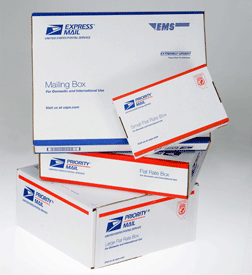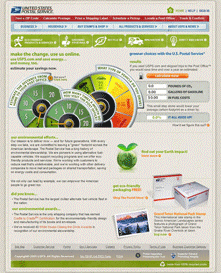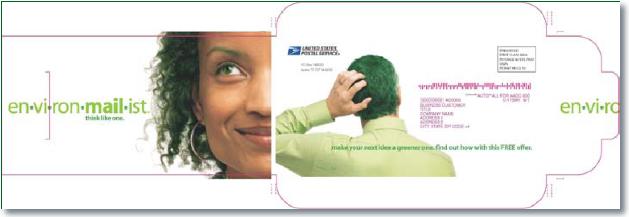Our Environment
Products and Services

USPS expedited shipping products are made from recycled content and soy-based inks. They are the only shipping products in the industry to receive Cradle-to-CradleSM Certification
From green packaging to online shopping, the Postal Service helps consumers and businesses make eco-friendly choices about their mail. We continuously work to reduce its environmental impact.
Product Innovation
We’re reducing waste and pollutants by expanding our use of recycled and recyclable products, harnessing the power of the Internet through usps.com to save customers unnecessary trips to Post Offices, and exploring numerous other ways to green the mail.
Cradle-to-Cradle Certification
In 2007, the Postal Service became the first of its peers to achieve Cradle-to- Cradle certification for its mailing supplies. Cradle-to-Cradle certification uses 39 specific criteria to assess the environmental attributes of inputs and outputs used in manufactured goods.
Before awarding the Postal Service its silver certification for mailing supplies, Cradle-to-Cradle certifiers spent almost two years examining our products, breaking them down to their 250 component materials and analyzing 1,400 individual ingredients.
All 200 suppliers contributing to the manufacture of USPS envelopes, packages and other supplies completed this demanding series of measurements and assessments. Maintaining these new, higher standards is now an integral part of doing business with the Postal Service.

To date, most of our Express Mail, Priority Mail and ReadyPost products have been Cradle-to-Cradle certified, as well as other supplies, such as decals, labels and packing tape.
In 2008, almost 900 million certified products were sold and distributed ― an increase of 18 percent over our first year of Cradle-to-Cradle certification. We continue to expand Cradle-to-Cradle certification. By next year, every stamp purchased at local Post Offices or online at usps.com will be Cradle-to-Cradle certified.
Consumers will not see any change in price, service or convenience as a result of using Cradle-to-Cradle mailing supplies. The switch to these environmentally beneficial materials has been cost neutral. There was no fee for obtaining Cradle-to-Cradle certification, other than the investment in time to look closely at the products we offer.
Cradle-to-CradleSM Certification
By the Numbers | |
| 10 | Number of primary suppliers USPS worked with to create new packaging materials. |
| 200 | Number of additional suppliers USPS worked with to create new packaging materials. |
| 60 | Number of USPS packaging items examined during certification. |
| 250 | Number of component materials examined during certification. |
| 1,400 | Number of individual ingredients in those component materials analyzed for environmental impact. |
| 99.99 | Percentage of ingredients used in USPS materials assessed for human and environmental health. |
| 39 | Number of human and environmental health criteria met for certification. |
| 2 | Number of years needed to complete the review and certification process. |
| 900 | In millions, number of Cradle-to-Cradle certified packages, envelopes and other supplies produced annually. |
| 1 | The Postal Service is the only shipping or packaging company to attain Cradle-to-Cradle certification. |
Direct Marketing

Find ways to lower your carbon footprint and learn what the Postal Service is doing to reduce its impact on the environment at usps.com/green
The Postal Service has sponsored several initiatives to quantify the environmental impact of mail, including the 2007 Environmental Impact of Mail study. The study showed that advertising mail has a net benefit to the environment by encouraging shopping from home, which reduces customer miles driven and harmful automotive emissions.
Direct mail advertising accounts for only 2.3 percent of landfill waste. However, any amount is too much, and we’re working with direct mailers, encouraging them to:
- Streamline address lists.
- Switch to recycled, lightweight papers produced with chemical-free processes.
- Use agri-based inks.
- Reduce printing waste.
Greening the Mail
2007, the Postal Service reinvigorated the Greening the Mail Task Force, originally formed in 1995. Participants include mailers, industry groups, suppliers, non-governmental organizations, the EPA and the White House Office of the Federal Environmental Executive. The task force is driving a multi-year effort to improve mailpiece design, improve address and list quality, expand recycling and waste-disposal practices related to mail, and improve communication on the impacts of mail on the economy and society.
Greening the Mail Task Force
The Postal Service created and chairs the Greening the Mail Task Force, a public-private partnership tasked with reducing the environmental impact of mail.
The mailing industry has taken great strides to become more environmentally responsible. The amount of Forest Stewardship Council-certified forests has tripled since 2004 to more than 281 million acres in 82 countries.
Many paper manufacturers have switched to more environmentally friendly bleaching solvents. List providers are already reducing wasted resources by focusing their lists more effectively. They also are providing consumers with more tools to opt out of unwanted mailings. The industry has worked hard to embrace the triple bottom line components of a sustainable business model.
Life Cycle Inventory
2007, the Postal Service developed a life cycle inventory (LCI) model to support the Greening the Mail Task Force in identifying the environmental impacts of different classes of mail. The LCI model offers a consistent, internationally recognized means of comparing products, and it is increasingly used by organizations to identify improvements to product sustainability. The model covers the entire life cycle of the mail, from mailpiece production through disposal, and identifies the most significant environmental impacts.
EnvironMAILism
We are encouraging marketers to become “EnvironMAILists,” people who implement greener direct mail techniques and processes. This helps reduce advertising mail waste.
Our EnvironMAIList campaign provides direct mailers printers, list vendors, agency professionals and marketing clients a handbook to introduce greener approaches to developing direct mail.
The campaign itself is a good example of mailing green. EnvironMAIList campaign materials are made using 30 percent post consumer waste, are Green Seal certified and carbon neutral. Energy to create the mailing comes from such diverse sources as wind power and hydro-electric power.
With the model, the Postal Service can perform a comparative analysis of the environmental aspects of different mail products. It provides us with information about the magnitude and distribution of the major environmental aspects of postal operations.
It also identifies portions of the mail life cycle that consume the most energy and generate the greatest amounts of pollution and waste, and it quantifies the share attributable to each major USPS product.
The task force will use the model’s results to prioritize initiatives that improve the environmental impact of mail throughout its life cycle.

Enhancing the Value of the Mail
The Postal Service is increasing mail’s value by helping consumers make environmentally friendly choices. Today’s customers look for convenience balanced with environmental responsibility. We’re helping them achieve this balance by going green.
Moreover, we’re encouraging consumers to shop from home by ordering goods and services online. Many consumers prefer to shop online and by catalog because of its convenience and flexibility.
USPS facilitates this process by picking up and delivering nearly 850 million packages a year, helping consumers save time, as well as reduce emissions and fuel use. We also deliver packages for other shipping firms, minimizing the number of total delivery trips to neighborhoods nationwide.
Businesses and households now find it easier to recycle or dispose of many products using the mail ― including computer equipment, printer supplies, cell phones, rechargeable batteries, compact fluorescent light bulbs and prescription drugs.
Through partnerships between businesses and government, mail is being used to properly dispose of products that might otherwise be harmful to the environment. For example, one state has partnered with USPS to provide the nation‘s first program to help consumers dispose of excess medicines by mail. This effort is important because pharmaceuticals don’t break down naturally and can contaminate lakes, streams and water supplies.
Consumers can put unused prescriptions or unwanted over-the-counter drugs in pre-addressed, postage-paid pouches available at many of the state’s pharmacies. They then mail the pouches to the state‘s drug enforcement agency for proper disposal.
These mail-back programs take advantage of the Postal Service’s national infrastructure, create customer convenience and promote innovative uses for the mail.
Lastly, we are bringing many USPS services online, further reducing customer trips to the post office. For example, customers can print postage-paid shipping labels using Click-N-Ship, schedule free package pickups and order mailing supplies online. Fully 44 percent of postal retail transactions now take place through the Internet, up from 38 percent in 2007.
|
|
|
